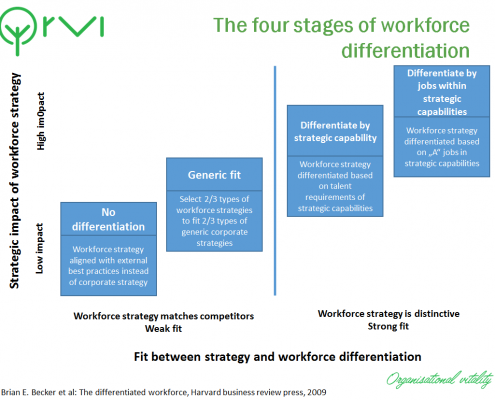Is a differentiated HR strategy the key to effective implementation of the business strategy?
The consulting company Bridges has been conducting its research on strategy implementation for 14 years. In the 2016 edition (http://www.implementation-hub.com/resources/implementation-surveys#) the research finds that the share of successful implementations has improved quite a bit. In 2002 the defined strategy was successfully implemented by one out of ten companies and by one out of three in 2016. We could agree it is a big improvement. But there are still two out of three companies that fail. The three main reasons for the failure specified by the board members are:
- Poor communication
- Lack of leadership
- Using the wrong measures
Looking at this reasons I see an opportunity for HR profession. Obviously, a great deal of problems with strategy implementation relate to people management. On the other hand, we can see that we are speaking about the same issues that have been on the table for years.
The new option HR expertise offers is a differentiated HR strategy. The main idea of the concept of a differentiated strategy is to understand and to take into account which job positions and which employees truly influence and truly contribute to the implementation of the business strategy. Strategically critical positions and well performing individuals in these positions should be granted more than proportional attention. This attention can be expressed through e.g. different recruiting procedure, different leadership style, rewarding, training and different career path for these positions.
A typical share of strategically critical positions (also called A positions) in a company is 10 to 15 percent. That means we have to also take care of the HR strategy dealing with the people without direct influence on business strategy implementation (also called B positions) but who – with their work – support the strategically critical players. They usually represent 70 to 80 percent of the workforce.
The third group of positions (also called C positions) may also represent 10 to 15 percent. These are the positions which are needed for the company to function but they don’t have strategic impact. The employees in these positions perform useful work and they deserve their own consideration through a specific part of the HR strategy.
With a differentiated HR strategy, we are able to redistribute the resources at our disposal for people development in accordance with the accepted business strategy. In that way, greater strategic impact can be achieved. Let us do a calculation. Currently we proportionally invest in people 1,000 units of resources. The A group receives 100 units and the rest get 900 units. If we slightly decrease the investment in B and C, let us say for 10 % these groups will still be receiving 810 units. The 90 units we saved can be redistributed to the A group which now receives 190 units. The resources available for the strategically critical positions are almost doubled.
The invested resources now better support the business strategy implementation. The HR department has played the role of a strategic partner to the top management.







